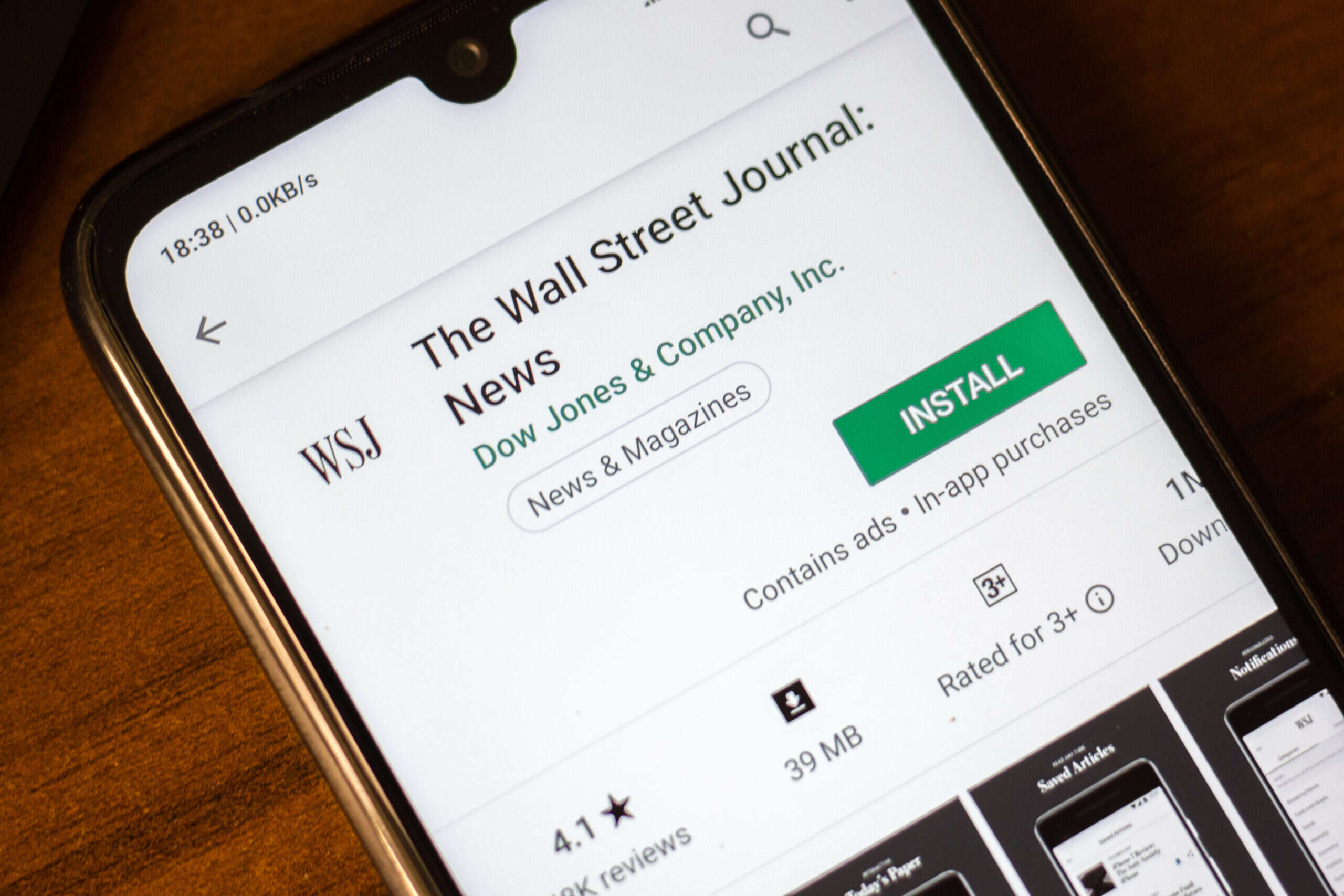
For journalism businesses, one of the surprise benefits of a global health crisis has proved to be the emergence of millions of new people who are willing to pay for online news.
As our new 100k Club research today shows, 24 leading English-language news publishers and publications now share more than 20m online subscriptions between them.
One of the major beneficiaries of this surge in new paying digital readers has been News Corp’s flagship business news brand, the Wall Street Journal.
The title, part of News Corp’s Dow Jones division, had 2m digital-only subscribers at the start of 2020. By the end of September, it had more than 2.35m, in addition to its 750,000 print subscribers.
In the latest news leader interview for Press Gazette’s new Media Monitor weekly newsletter, we spoke to Karl Wells, the Wall Street Journal’s general manager for membership, subscription sales and marketing. He reveals some of the techniques his team used to drive up digital subscription numbers during the Covid-19 crisis.
“If five years ago, subscriptions were more art than science, I would say now subscriptions are more science than art,” he tells Press Gazette. “Big data is not a recent thing, but I suppose the application that you can build on top of big data is what we’ve done to drive a lot of business performance”
He also explains how the Covid-19 subscriptions model used by the Journal can be reproduced to “leverage” other major news events, as it did with this year’s US election.
The model will be needed to help the Wall Street Journal meet its long-term growth ambitions.
Dow Jones executives recently laid out plans to double subscriptions across its titles – which also include Barron’s, Financial News and MarketWatch – in the coming years. The target was set after research by the company found that there are an estimated 12m people across the US who are “likely or very likely” to subscribe to a Dow Jones title.
How the Wall Street Journal used Covid-19 to increase membership
“I still remember having to sit there and hit ‘refresh’ – like, is that really the number we’re seeing, both in terms of traffic and subscription sales?” says Wells, recalling the surge in online views the Journal’s website received last spring as readers attempted to understand the unfolding Covid-19 crisis.
As well as offering insight into the health and politics side of coronavirus, the WSJ – as one of the world’s most respected authorities on financial news – was well placed to guide readers through the economics of the pandemic.
In March, as interest in the pandemic grew, the Journal – along with rivals like the New York Times and Washington Post – decided to make much of its coronavirus coverage available for free.
Wells says the WSJ decided it had “a public service that we felt very strongly we needed to provide people”. The other incentive for the Journal and its rivals was the opportunity to reach new readers and sign up new paying subscribers.
“Because of the unprecedented demand, we saw it as an opportunity to allow people to swim around our product more than we normally would,” says Wells, who previously worked at News UK as director of subscriptions growth at the Sun.
“Our paywall is a propensity-led model, so [the] level of access is determined by an algorithm that understands your likelihood to buy,” he adds, explaining that this tool is used to determine when certain visitors are “becoming habitual” and so are likely to sign up for a subscription.
The Journal’s technology then used a reader’s assumed “propensity to pay” to decide their subscription offer. “We had multiple variations out in market,” says Wells. “And because we had so much traffic we could run multiple variant testing for a good couple of weeks.”
He says the most popular offer proved to be an introductory rate of $1 for two months, renewing into a half-price offer for a year.
“At the time, we felt like that would take us out of Covid, into the election and into inauguration and beyond. As it turns out, we are still in Covid.”
A new ‘treasure trove’ of reader information

Karl Wells formerly headed up subscriptions for the Sun at News UK
During the Covid-19 subscriber influx, the WSJ also introduced a new survey box to find out more about its readers.
“We saw this as an opportunity to immediately learn more about who this audience were,” says Wells. “We were scratching our heads a bit and saying, well, we’re seeing millions more people come – who are they? Do we need to change anything within the product?
“So in our on-boarding flow, we were asking many more questions of our audience. We were asking their job title, their profession, the industry that they worked in, their interest as it relates to the Wall Street Journal. And what that gave us was a treasure trove of understanding who the audience were.”
He adds: “Before Covid, we had one on-boarding card that was more related to your profession. What we added was a card that allows you to express what you’re interested in as it relates to what’s within the Journal. What that means is that from day one you can start to tailor things which link to what they’ve said they’re interested in.”
The other main Covid-19 consideration for the Journal was handling cancellations.
“What do we do when members call up and say, ‘I don’t want my newspaper any more because it might be carrying Covid’? What do we do if someone calls up and says, ‘I’ve lost my job, I can’t afford my subscription’?”
For the print problem, Wells says: “We spun up two new products literally within a matter of weeks to allow print subscribers to have their print experience delivered to them digitally – the like-for-like replica of the edition. And that proved popular – in the tens of thousands. Obviously we got to a point where it was understood that Covid would not carry on newsprint, but we didn’t know that at the time.”
And for newly unemployed people who felt they couldn’t afford their subscription, Wells says the Journal “created a save offer for anyone that cited loss of job for a reason of cancellation. We gave them the best offer we give people within the call centre so they wouldn’t have to cancel their subscription and lose their job at the same time.”
How Apple and Facebook can help Journal reach new audience heights
As the largest constituent of Dow Jones, the Wall Street Journal will play a key role in the division’s efforts to double its subscription base – from just short of 4m – in the coming years.
Dow Jones research, revealed to investors in September, estimated that there are 12m people across the US who would be “likely or very likely” to subscribe to its titles.
A key challenge for Wells and colleagues is finding these people.
In addition to making the most of large news events, the WSJ is also finding its participation in external platforms like Apple News+ and Facebook News helpful for reaching new audiences. Other publishers have their frustrations with Apple News+ and Facebook News – as explored in Press Gazette’s Platform Profile series – but they appear to be working well for the WSJ currently.
“One of the key metrics we look at every week is the top-read articles by AN+ members, and we compare them to the top-read articles [on our website],” says Wells. “And what we’re looking for is there to be minimal overlap. The reason for that is we see AN+ as almost like an advertising campaign for our content on a different platform.
“And what we’ve found from what we can see on our own dashboards is the audience on AN+ is much more female than what we have in our base, much younger. And then unsurprisingly, therefore, their content consumption is therefore different to our base. Which we like.”
He adds: “You’ve got to start somewhere, and if your brand’s not front of mind for someone then you can’t just expect that they’re going to come to your own [website] and then you’re away.
“Publishers have to be flexible in how they see these partnerships – you dip your toe in the water and see how it goes. And I think for us, we’re probably a little bit different in the sense of who we are what we stand for. [We have] a big focus on business, markets, economy – which is what we’re known for. But there is accessible journalism linked to that, [which] is appealing to younger people too.”
Facebook News, he says, is also seen as “a way of exposing people to our journalism who otherwise don’t necessarily have our brand front of mind. The beauty of it though is that it is directing people to our owned and operated. Obviously the difference with AN+ is you are reading our journalism from the Apple News+ app.”
Trump slump? Not an issue for us, says WSJ
One of the upcoming issues for many of the US publications in Press Gazette’s 100k Club is the end of Donald Trump’s presidency.
The New York Times, which leads the digital subscriber league table, has made no secret of the ‘Trump bump’ that led to a boost in readership after the president’s 2016 election.
Wells predicts Trump’s departure from the White House will not be an issue for the Wall Street Journal, which prides itself on being politically neutral (the newspaper has not endorsed a presidential candidate since 1928).
“Thankfully for us, we didn’t really trade off Trump in that sense,” he says. “We purposely didn’t back ourselves into a positioning that relied upon an individual as president. So from that perspective, no, we didn’t trade on it and therefore we’re not going to suffer as a result of him not being there.
“We are often cited as the most trusted newspaper in America, most trusted on the left and most trusted on the right. So from that perspective, we’re down the middle and we don’t pick a horse. Thankfully, we didn’t pick a horse, which means that it’s not going to have that kind of impact.”
Nevertheless, covering one of the most contentious presidential elections in US history could well prove to have been another boost for the Journal (it has not yet revealed figures for the end of 2020). On the day of the election, the WSJ made its website free to access, mirroring its approach to Covid-19.
“The one thing that Covid showed is that there is a formula for success when it comes to leveraging big news events,” says Wells. “And our approach to what we did in the election was a lift and shift in many respects…
“I think what we’ve done is create a scalable and repeatable model that we can apply to big news events, which is pleasing.”
Top picture: Shutterstock/ Sharaf Maksumov
Email pged@pressgazette.co.uk to point out mistakes, provide story tips or send in a letter for publication on our "Letters Page" blog
